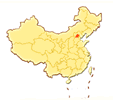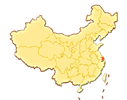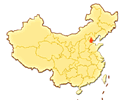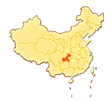|
|
|
|||||||||||
|
Beijing |
 Beijing
Called "Jing" for short, Beijing is the capital of the People's
Republic of China, situated at the northwestern end of the North China Plain.
Initially named Ji, Beijing was the capital of the State of Yan during the
Spring and Autumn Period (770-476 B.C.) and the Warring States Period (475-221
B.C.), and the secondary capital under the name of Yanjing during the Liao
Dynasty (916-1125). It also served as the capital during the Jin (1115-1234),
Yuan (1206-1368), Ming (1368-1644) and Qing (1644-1911) dynasties and the
early period of the Republic of China (1912-1949), and was called Zhongdu,
Dadu, Beiping and Beijing successively. It was established as a municipality
in 1928. Beijing
Called "Jing" for short, Beijing is the capital of the People's
Republic of China, situated at the northwestern end of the North China Plain.
Initially named Ji, Beijing was the capital of the State of Yan during the
Spring and Autumn Period (770-476 B.C.) and the Warring States Period (475-221
B.C.), and the secondary capital under the name of Yanjing during the Liao
Dynasty (916-1125). It also served as the capital during the Jin (1115-1234),
Yuan (1206-1368), Ming (1368-1644) and Qing (1644-1911) dynasties and the
early period of the Republic of China (1912-1949), and was called Zhongdu,
Dadu, Beiping and Beijing successively. It was established as a municipality
in 1928.
Covering an area of 16,800 square km, Beijing has under its jurisdiction 16 districts and two counties. Its permanent residents (referring to those living for more than half a year in Beijing) total over 14.23 million. The statistics provided by public security departments demonstrate that Beijing's population with registered permanent residence stood at 11.36 million at the end of 2002. Beijing is China's political, cultural, scientific and educational center as well as a hub of communications. It is also a world-famous tourist destination, with abundant places of historic interest and scenic spots, including the Palace Museum, the Temple of Heaven, the Great Wall, the Ming Tombs (tombs of 13 Ming emperors), the Summer Palace and the Fragrant Hill. |
|
Shanghai |
 Shanghai
Called "Hu" for short, Shanghai is situated at the estuary of
the Yangtze River in the middle section of China's eastern coast. A fishing
village in ancient times, Shanghai was under the State of Wu during the
Spring and Autumn Period (770-476 B.C.). It was established as a town under
the name of Shanghai in the Song Dynasty (960-1279), and became a city in
1927. Shanghai
Called "Hu" for short, Shanghai is situated at the estuary of
the Yangtze River in the middle section of China's eastern coast. A fishing
village in ancient times, Shanghai was under the State of Wu during the
Spring and Autumn Period (770-476 B.C.). It was established as a town under
the name of Shanghai in the Song Dynasty (960-1279), and became a city in
1927.
One of China's four municipalities directly under the Central Government, Shanghai, covering 5,800 square km, has under its jurisdiction 18 districts and one county. Its population with registered permanent residence was around 13.35 million at the end of 2002. Shanghai is the largest city in China and one of the major metropolises in the world. It is also the country's top industrial city, commercial and financial center, as well as scientific and technological base. |
|
Tianjin |
 Tianjin
Called "Jin" for short, Tianjin is situated in the northeast of
the North China Plain, where the five major tributaries of the Haihe River
converge and empty into the Bohai Sea. Named Zhigu during the Jin (1115-1234)
and Yuan (1279-1368) dynasties, Tianjin was an important place for transporting
grain to the capital by waterway. Later the settlement of a town under the
name of Haijin was built. The settlement became a garrison town named Tianjinwei
(Defense of the Heavenly Ford) in the early Ming Dynasty (1368-1644) and
was the seat of Tianjin prefectural government during the Qing Dynasty (1644-1911).
It became a city in 1928. Tianjin
Called "Jin" for short, Tianjin is situated in the northeast of
the North China Plain, where the five major tributaries of the Haihe River
converge and empty into the Bohai Sea. Named Zhigu during the Jin (1115-1234)
and Yuan (1279-1368) dynasties, Tianjin was an important place for transporting
grain to the capital by waterway. Later the settlement of a town under the
name of Haijin was built. The settlement became a garrison town named Tianjinwei
(Defense of the Heavenly Ford) in the early Ming Dynasty (1368-1644) and
was the seat of Tianjin prefectural government during the Qing Dynasty (1644-1911).
It became a city in 1928.
Covering an area of more than 11,000 square km, Tianjin is now a municipality directly under the Central Government, having 15 districts and three counties under its jurisdiction. Its permanent population exceeded 10.07 million at the end of 2002, including over 9.19 million with registered residence. Tianjin is the largest industrial city, a major commercial center and a port in north China, with abundant oil, gas and sea salt resources. Famous scenic spots and historical sites in Tianjin include Ningyuan Park, Tianhougong Temple, Dagukou Battery, Dule Temple (Monastery of Solitary Happiness) in Jixian County, the Great Wall at Huangyaguan and Panshan Mountain, known as No.1 mountain east of Beijing. |
|
Chongqing |
 Chongqing
Called "Yu" for short, Chongqing is situated on the upper reaches
of the Yangtze River in the east of southwest China. It was under the State
of Ba during the Spring and Autumn Period (770-476 B.C.) and the Warring
States Period (475-221 B.C.) and was administered by Yuzhou during the Sui
(581-618) and Tang (618-907) dynasties. It was the secondary capital of
the Kuomintang government during the War of Resistance Against Japanese
Aggression (1937-45). Chongqing
Called "Yu" for short, Chongqing is situated on the upper reaches
of the Yangtze River in the east of southwest China. It was under the State
of Ba during the Spring and Autumn Period (770-476 B.C.) and the Warring
States Period (475-221 B.C.) and was administered by Yuzhou during the Sui
(581-618) and Tang (618-907) dynasties. It was the secondary capital of
the Kuomintang government during the War of Resistance Against Japanese
Aggression (1937-45).
Chongqing was designated as a municipality directly under the Central Government in 1997, consisting of three prefectural-level cities-Chongqing, Wanxian and Fuling-and Qianjiang Prefecture formerly under Sichuan Province. Chongqing has under its jurisdiction 15 districts, four county-level cities, 17 counties and four autonomous counties. Covering 82,300 square km, it had a population of 31.07 million at the end of 2002, with some 19.76 million living in the countryside and 11.31 million being urban residents. Chongqing is encircled by Dabashan, Wushan and Daloushan mountains on the north, east and south. The Yangtze River traverses the municipality, cutting through high mountains, forming the famous Three Gorges. Chongqing has an annual precipitation of over 1,000 mm, and is nicknamed a "foggy city" due to its foggy weather in winter and spring. It has rich forest and mineral resources, producing over 1,000 kinds of traditional Chinese medicinal herbs, tung oil and raw lacquer. Home to such rare fauna and flora as Chinese sturgeon and metasequoia, Chongqing is also a comprehensive industrial city and a famous tourist destination. |